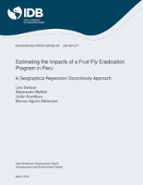Estimating the Impacts of a Fruit Fly Eradication Program in Peru: A Geographical Regression Discontinuity Approach
Date
Mar 2016
In this paper, we evaluate the short term impact of a Fruit Fly Eradication Program in the coastal areas of Peru. Exploiting arbitrary variation in the program's intervention borders, as well as precise geographic location data of farmer's households, we use a Geographical Regression Discontinuity (GRD) approach to identify the program's effects on agricultural outcomes. For this purpose, baseline and follow up surveys were collected for 615 households -307 treated and 308 controls- . Baseline data shows that producer and farm-level characteristics in treated and control areas are balanced. This confirms that the program's intervention borders were set only as a function of financial and logistic restrictions and independently of the pest incidence levels and/or other producer and/or farm characteristics. The results show that farmers in treated areas improved pest knowledge and are more likely to implement best practices for plague prevention and control. Beneficiary farmers also present increased fruit crops productivity and sales. The robustness of these findings is confirmed using placebo tests.




